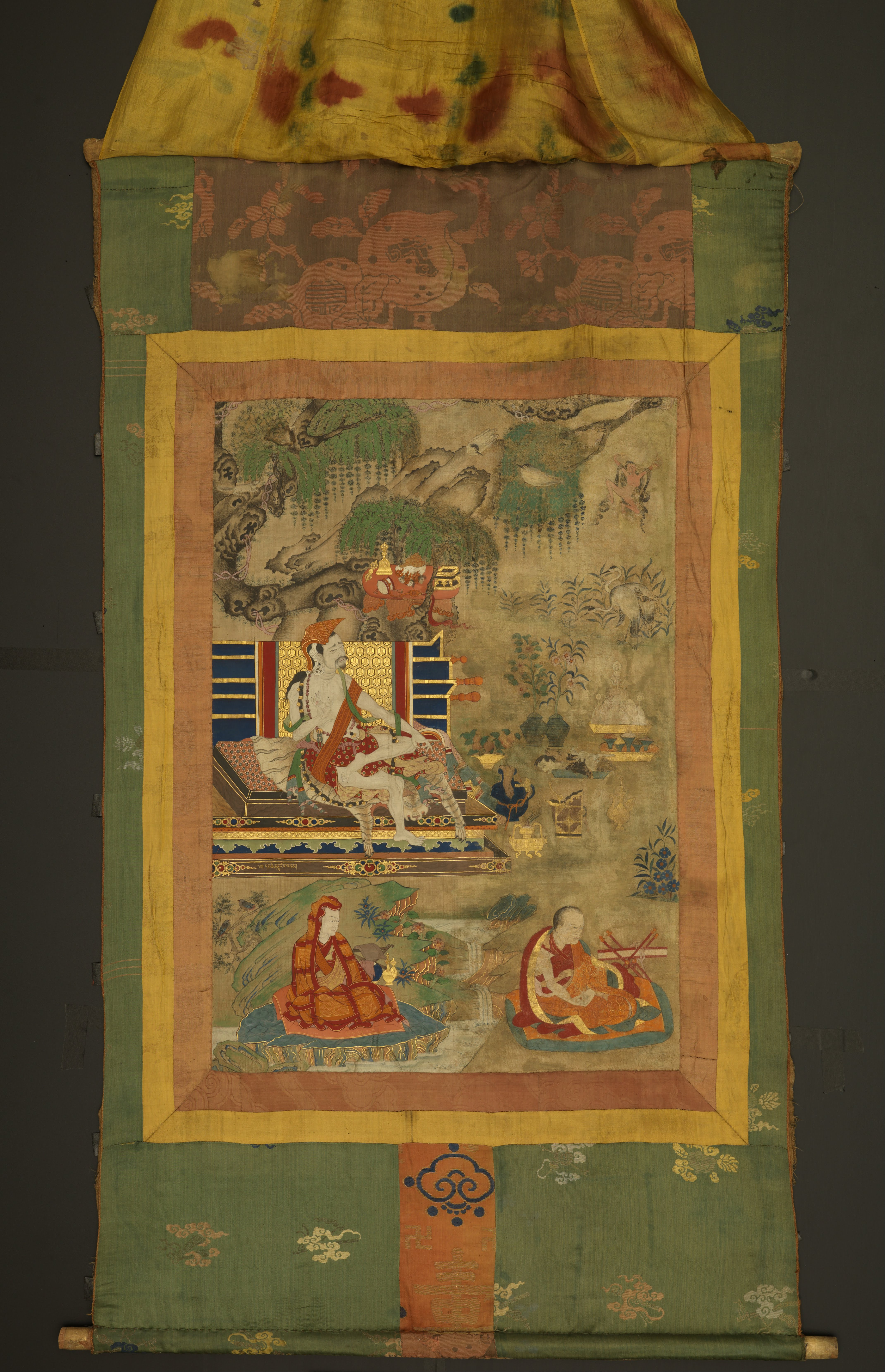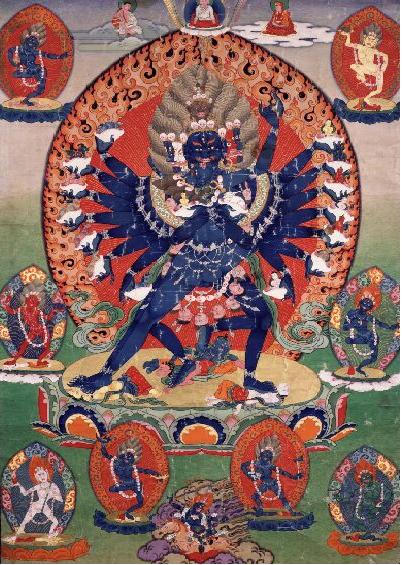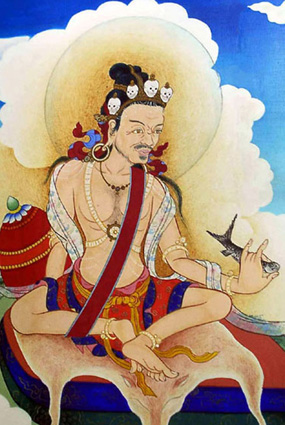|
Lawapa
Lawapa or Lavapa () was a figure in Tibetan Buddhism who flourished in the 10th century. He was also known as Kambala and Kambalapada (Sanskrit: ). Lawapa, was a mahasiddha, or accomplished yogi, who travelled to Tsari. Lawapa was a progenitor of the Dream Yoga sādhanā and it was from Lawapa that the mahasiddha Tilopa received the Dream Yoga practice lineage. Bhattacharya, while discussing ancient Bengali literature, proffers that Lawapa composed the '' Kambalagītika'' ( "Lawapa's Song") and a few songs of realization in the ''Charyapada''. Simmer-Brown (2001: p. 57) when conveying the ambiguity of ḍākinīs in their "worldly" and "wisdom" guises conveys a detailed narrative that provides the origin of Lawapa's name: Nomenclature, orthography and etymology Alternate English orthographies are Lwabapa, Lawapa and Lvapa. Simmer-Brown, Judith (2001). ''Dakini's Warm Breath: the Feminine Principle in Tibetan Buddhism''. Boston, USA: Shambhala. (alk. paper): p. 57; p. 31 ... [...More Info...] [...Related Items...] OR: [Wikipedia] [Google] [Baidu] |
Six Yogas
The Six Dharmas of Nāropa (, Skt. ''ṣaḍdharma'', "Naro's six doctrines" or "six teachings"), are a set of advanced Tibetan Buddhist tantric practices compiled by the Indian mahasiddhas Tilopa and Nāropa (1016-1100 CE) and passed on to the Tibetan translator-yogi Marpa Lotsawa (c. 1012). Another name for the six Dharmas is "the oral instruction transmission for achieving liberation in the bardo," or "the ''Bardo Trang-dol'' system". Bardo here, refers to the three bardos of waking, sleep and dying. They are also referred to as "the path of means" (''thabs lam'') in Kagyu literature.Kragh (2015), p. 345. They are also sometimes called the ''Six Yogas of Nāropa'' (though not in the traditional literature which never uses the term ''ṣaḍaṅga-yoga'' or ''sbyor-drug''). The six dharmas are a collection of tantric Buddhist completion stage practices drawn from the Buddhist tantras. They are intended to lead to Buddhahood in an accelerated manner. They traditionally require ... [...More Info...] [...Related Items...] OR: [Wikipedia] [Google] [Baidu] |
Hevajra Tantra
Hevajra (Tibetan: kye'i rdo rje / kye rdo rje; Chinese: 喜金剛 Xǐ jīngāng / 呼金剛 Hū jīngāng;) is one of the main yidams (enlightened beings) in Tantric, or Vajrayana Buddhism. Hevajra's consort is Nairātmyā (Tibetan: bdag med ma). History India The Hevajra Tantra, a yoginītantra of the ''anuttarayogatantra'' class, is believed to have originated between the late 8th (Snellgrove), and the late 9th or early 10th centuries (Davidson), in Eastern India, possibly Kamarupa. Tāranātha lists Saroruha and Kampala (also known as "Lva-va-pā", "Kambhalī", and "Śrī-prabhada") as its "bringers": .. the foremost yogi Virupa meditated on the path of Yamāri and attained siddhi under the blessings of Vajravārāhi,...His disciple Dombi Heruka..understood the essence of the Hevajra Tantra, and composed many śāstras like the ''Nairātmā-devi-sādhana'' and the ''Sahaja-siddhi''. He also conferred abhiṣeka on his own disciples. After this, two ācāryas Lva-va- ... [...More Info...] [...Related Items...] OR: [Wikipedia] [Google] [Baidu] |
Dream Yoga
Dream yoga or ''milam'' (; sa, स्वप्नदर्शन, ''svapnadarśana'')—the Yoga of the Dream State—is a suite of advanced tantric sadhana of the entwined Mantrayana lineages of Dzogchen ( Nyingmapa, Ngagpa, Mahasiddha, Kagyu and Bönpo). Dream yoga consists of tantric processes and techniques within the trance Bardos of Dream and Sleep ( bo, script=latn, mi-lam bardo) Six Dharmas of Naropa. In the tradition of the tantra, the dream yoga method is usually passed on by a qualified teacher to his/her students after necessary initiation. Various Tibetan lamas are unanimous that it is more of a passing of an enlightened experience rather than any textual information. The 'dream body' and the 'bardo body' have been identified with the 'vision body' (Tibetan: ''yid lus''): In the yoga of dreaming (''rmi lam, *svapna''), the yogi learns to remain aware during the states of dreaming (i.e. to lucid dream) and uses this skill to practice yoga in the dream. Bon Nyi ... [...More Info...] [...Related Items...] OR: [Wikipedia] [Google] [Baidu] |
Charyapada
The Charyapada (IAST: Caryapāda, Assamese language, Assamese/Bengali language, Bengali: চর্যাপদ) is a collection of mystical poems, songs of realization in the Vajrayana tradition of Buddhism from the tantra, tantric tradition in Assam, Bengal, Bihar and Odisha. It was written between the 8th and 12th centuries in an Abahatta that was the ancestor of the Assamese language, Assamese, Bengali language, Bengali, Bhojpuri language, Bhojpuri, Odia language, Odia, Magahi language, Magahi, Maithili language, Maithili, and many other Eastern Indo-Aryan languages, and it is said to be the oldest collection of verses written in those languages. ''Charyāpada'' written in the script resembles the most closest form of Bengali–Assamese languages used today. A palm-leaf manuscript of the ''Charyāpada'' was rediscovered in the early 20th century by Haraprasad Shastri at the Nepal Royal Court Library. The ''Charyapada'' was also preserved in the Tibetan Buddhist canon. As son ... [...More Info...] [...Related Items...] OR: [Wikipedia] [Google] [Baidu] |
Songs Of Realization
Songs of realization, or Songs of Experience (; Devanāgarī: दोहा; Romanized Sanskrit: ''Dohā''; Oriya: ପଦ), are sung poetry forms characteristic of the tantric movement in both Vajrayana Buddhism and in Hinduism. Doha is also a specific poetic form. Various forms of these songs exist, including caryagiti ( sa, caryāgīti), or 'performance songs' and vajragiti (Sanskrit: ''vajragīti'', Tibetan: ''rDo-rje gan-sung'' ), or 'diamond songs', sometimes translated as vajra songs and doha (Sanskrit: ''dohā'', दोह, 'that which results from milking the cow'), also called doha songs, distinguishing them from the unsung Indian poetry form of the doha. According to Roger Jackson, caryagiti and vajragiti "differ generically from dohās because of their different context and function"; the doha being primarily spiritual aphorisms expressed in the form of rhyming couplets whilst caryagiti are stand-alone performance songs and vajragiti are songs that can only be understood ... [...More Info...] [...Related Items...] OR: [Wikipedia] [Google] [Baidu] |
Tilopa
Tilopa (Prakrit; Sanskrit: Talika or Tilopadā; 988–1069) was an Indian Buddhist monk in the tantric Kagyu lineage of Tibetan Buddhism. He lived along the Ganges River, with wild ladies as a tantric practitioner and mahasiddha. He practiced Anuttarayoga Tantra, a set of spiritual practices intended to accelerate the process of attaining Buddhahood. He became a holder of all the tantric lineages, possibly the only person in his day to do so. As well as the way of insight, and Mahamudra he learned and passed on the Way of Methods, today known as the 6 Yogas of Naropa, and guru yoga. Naropa is considered his main student. Life Tilopa was born into the priestly caste – according to some sources, a royal family – but he adopted the monastic life upon receiving orders from a dakini (female buddha whose activity is to inspire practitioners) who told him to adopt a mendicant and itinerant existence. From the beginning, she made it clear to Tilopa that his real parents were ... [...More Info...] [...Related Items...] OR: [Wikipedia] [Google] [Baidu] |
Yeshe Tsogyal
Yeshe Tsogyal (c. 757 or 777 – 817 CE) , also known as "Victorious Ocean of Knowledge", "Knowledge Lake Empress" (, ཡེ་ཤེས་མཚོ་རྒྱལ), or by her Sanskrit name ''Jñānasāgara'' "Knowledge Ocean", or by her clan name "Lady Kharchen", attained enlightenment in her lifetime and is considered the Mother of Tibetan Buddhism. Yeshe Tsogyal is the highest woman in the Nyingma Vajrayana lineage. Some sources say she, as Princess of Karchen, was either a wife or consort of Tri Songdetsen, emperor of Tibet, when she began studying Buddhism with Padmasambhava, who became her main karmamudrā consort. Padmasambhava is a founder-figure of the Nyingma tradition of Tibetan Buddhism, and is considered as a second buddha of our era. She is known to have revealed terma with Padmasambhava and was also the main scribe for these terma. Later, Yeshe Tsogyal also hid many of Padmasambhava's terma on her own, under the instructions of Padmasambhava for future generation ... [...More Info...] [...Related Items...] OR: [Wikipedia] [Google] [Baidu] |
Trance
Trance is a state of semi-consciousness in which a person is not self-aware and is either altogether unresponsive to external stimuli (but nevertheless capable of pursuing and realizing an aim) or is selectively responsive in following the directions of the person (if any) who has induced the trance. Trance states may occur involuntarily and unbidden. The term ''trance'' may be associated with hypnosis, meditation, magic, flow, prayer, and altered states of consciousness. Etymology Trance in its modern meaning comes from an earlier meaning of "a dazed, half-conscious or insensible condition or state of fear", via the Old French ''transe'' "fear of evil", from the Latin ''transīre'' "to cross", "pass over". Working models Wier, in his 1995 book, ''Trance: from magic to technology'', defines a simple trance (p. 58) as a state of mind being caused by cognitive loops where a cognitive object (a thought, an image, a sound, an intentional action) repeats long enough to res ... [...More Info...] [...Related Items...] OR: [Wikipedia] [Google] [Baidu] |
Anuttarayogatantra
Classes of Tantra in Tibetan Buddhism refers to the categorization of Buddhist tantric scriptures in Indo-Tibetan Buddhism. Tibetan Buddhism inherited numerous tantras and forms of tantric practice from medieval Indian Buddhist Tantra. There were various ways of categorizing these tantras in India. In Tibet, the Sarma (New Translation) schools categorize tantric scriptures into four classes, while the Nyingma (Ancients) school use six classes of tantra. Sarma ("New Translation") classification The Sarma, "New Translation" schools of Tibetan Buddhism (Gelug, Sakya, Kagyu, Jonang) classify tantric practices and texts into four. In this, they follow Indian Tantric Buddhists such as Abhayākara, who makes this distinction in his ''Clusters of Quintessential Instructions''. Tantras are classified according to the capacity of persons, the deities they use, the specific types of methods they employ and how they use desire (''kama'').Tsong-kha-pa, ''The Great Exposition of Secret Mantr ... [...More Info...] [...Related Items...] OR: [Wikipedia] [Google] [Baidu] |
Kampala
Kampala (, ) is the capital and largest city of Uganda. The city proper has a population of 1,680,000 and is divided into the five political divisions of Kampala Central Division, Kawempe Division, Makindye Division, Nakawa Division, and Rubaga Division. Kampala's metropolitan area consists of the city proper and the neighboring Wakiso District, Mukono District, Mpigi District, Buikwe District and Luweero District. It has a rapidly growing population that is estimated at 6,709,900 people in 2019 by the Uganda Bureau of Statistics in an area of . In 2015, this metropolitan area generated an estimated nominal GDP of $13.80221 billion (constant US dollars of 2011) according to Xuantong Wang et al., which was more than half of Uganda's GDP for that year, indicating the importance of Kampala to Uganda's economy. Kampala is reported to be among the fastest-growing cities in Africa, with an annual population growth rate of 4.03 percent, by City Mayors. Mercer (a New York- ... [...More Info...] [...Related Items...] OR: [Wikipedia] [Google] [Baidu] |








